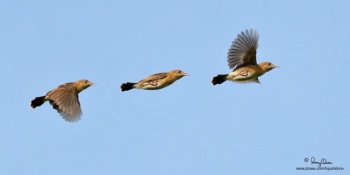Alternative names: Gold-naped Cisticola, Gold-capped Cisticola, Bright-capped Cisticola, Yellow-headed Cisticola, Golden Cisticola, Bright-headed Cisticola
- Cisticola exilis
Identification
9 cm (3½ in)
- Streaked upperparts
- Tail rounded: shorter in breeding plumage
Distribution
Eurasia and Australasia:
Asia: China, Tibet, Nepal, India, Eastern and Western Himalayas, Bangladesh, Taiwan and Hong Kong
Southeast Asia: Indochina, Myanmar, Laos, Vietnam, Thailand, Malaysia, Philippines, Island of Borneo, Indonesia, Greater Sundas, Sumatra, Java, Sulawesi, Lesser Sundas, Bali and Island of Timor
Australasia: Papua New Guinea, Australia: New South Wales, Northern Territory, Queensland, South Australia, Tasmania, Victoria, Western Australia and Melanesia
Taxonomy
Subspecies
Cisticola exilis has 12 subspecies[1]:
- C. e. tytleri: Foothills of Nepal to north-eastern India, northern Myanmar and south-western China (Yunnan)
- C. e. erythrocephalus: Southern India (southern Mysore, western Tamil Nadu and Kerala)
- C. e. equicaudatus: Eastern Myanmar to central Thailand, Cambodia and southern Vietnam
- C. e. courtoisi: South-eastern China (south-eastern Yunnan to southern Hunan, Jiangxi and Fujian)
- C. e. volitans: Taiwan
- C. e. semirufus: Philippine Islands and Sulu Archipelago
- C. e. rusticus: Sulawesi subregion and southern Moluccas
- C. e. lineocapilla: Java, Bali, Lesser Sundas and northern Australia (Northern Territory)
- C. e. diminutus: New Guinea to Solomon Islands and islands in Torres Strait
- C. e. polionotus: Bismarck Archipelago
- C. e. alexandrae: Northern Australia (Pilbara region to Mackenzie River, Queensland)
- C. e. exilis: Eastern Australia (central Queensland to southern Victoria and adjacent South Australia)
Habitat
Tall grass and reeds around marshes and wetlands, including sewage ponds and rice fields. Also field edges on lower mountain slopes.
Behaviour
Diet
Their diet consists mostly of small insects, ants, caterpillars, moths etc.
Breeding
They time their breeding effort to the rainy season.
References
- Clements, J. F., T. S. Schulenberg, M. J. Iliff, D. Roberson, T. A. Fredericks, B. L. Sullivan, and C. L. Wood. 2018. The eBird/Clements checklist of birds of the world: v2018. Downloaded from http://www.birds.cornell.edu/clementschecklist/download/
- BF Member observations
- Avibase
- Handbook of the Birds of the World Alive (retrieved May 2014 and August 2018)
Recommended Citation
- BirdForum Opus contributors. (2024) Golden-headed Cisticola. In: BirdForum, the forum for wild birds and birding. Retrieved 26 April 2024 from https://www.birdforum.net/opus/Golden-headed_Cisticola
External Links








